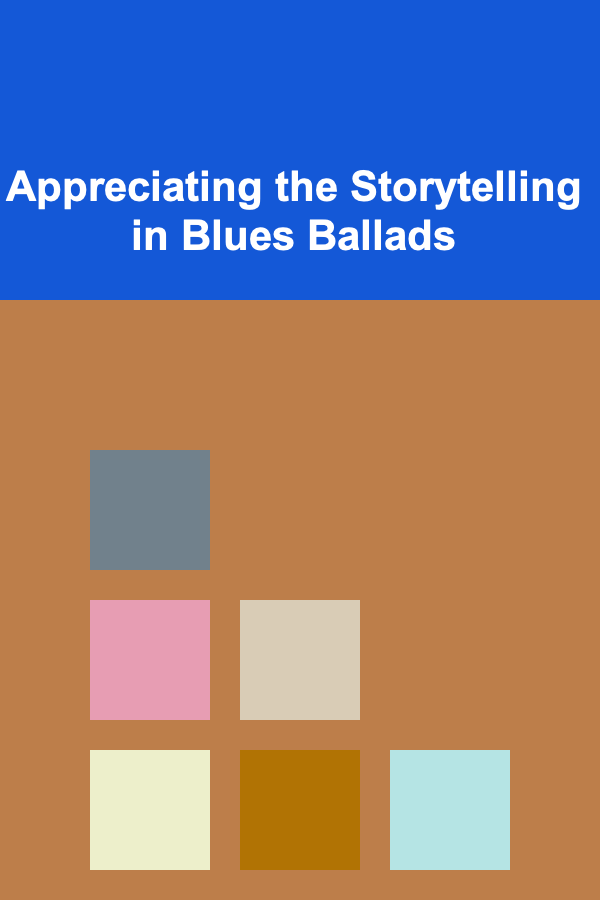
Appreciating the Storytelling in Blues Ballads
ebook include PDF & Audio bundle (Micro Guide)
$12.99$10.99
Limited Time Offer! Order within the next:

The blues, often perceived as a genre steeped in melancholic emotions and simple musical structures, possesses a profound depth when examined through the lens of storytelling. Blues ballads, in particular, serve as vital historical documents and artistic expressions, narrating tales of hardship, resilience, love, loss, and the socio-political realities of marginalized communities, primarily African Americans in the early 20th century. To truly appreciate the artistry of these ballads, one must delve beyond the surface level of the music and explore the rich tapestry of narratives woven within the lyrics, melodies, and performance styles.
The Blues as Oral History
Before the widespread availability of recording technology, the blues ballad functioned as a crucial form of oral history, preserving and transmitting experiences that were often ignored or actively suppressed by mainstream society. These songs were not merely entertainment; they were chronicles of daily life, survival strategies, and cultural resistance. They documented the realities of sharecropping, migration from the rural South to the industrial North, Jim Crow laws, and the constant struggle for economic and social justice.
Consider, for example, the prevalence of songs about floods, particularly the Mississippi River flood of 1927. These weren't just weather reports set to music; they were accounts of devastation, displacement, and the government's inadequate response to the suffering of African American communities. Artists like Bessie Smith and Blind Willie McTell immortalized these experiences, providing firsthand accounts that challenged the official narratives and gave voice to the voiceless. The lyrics often spoke of broken levees, lost homes, and the desperation of people clinging to rooftops, waiting for rescue that often never came.
Moreover, the blues provided a space for encoding information that couldn't be openly discussed. Songs could use metaphors and double entendres to address sensitive topics like racial discrimination, police brutality, and sexual exploitation. This coded language allowed artists to communicate subversive messages while navigating the precarious social and political landscape of the time. Listeners, attuned to the nuances of the language and the shared experiences, understood the deeper meaning embedded within the seemingly simple verses.
Narrative Structures and Lyrical Devices
Blues ballads often employ specific narrative structures and lyrical devices that contribute to their storytelling power. While the classic 12-bar blues structure provides a musical framework, the lyrical content is where the narrative unfolds. The AAB pattern (two lines stating a problem or situation, followed by a resolving or reflecting line) is a common feature, creating a sense of call and response that mirrors the communal nature of the blues tradition.
The use of vivid imagery and sensory details is another hallmark of blues storytelling. Artists paint pictures with their words, transporting listeners to the dusty roads of the Mississippi Delta, the smoky juke joints of Chicago, or the cramped tenements of Harlem. They evoke the sounds of the train whistle, the taste of cheap whiskey, the feel of rough cotton in their hands, and the weight of despair in their hearts. This attention to detail creates a powerful sense of realism and allows listeners to connect with the characters and situations on a visceral level.
Furthermore, the use of metaphor and symbolism is prevalent. The train, for instance, is often used as a symbol of escape, freedom, and the possibility of a better life. The devil, a recurring figure in blues lore, can represent temptation, inner demons, or the external forces of oppression. The Mississippi River, in addition to being a literal geographical feature, can symbolize the flow of life, the power of nature, and the enduring legacy of slavery and injustice.
Consider Robert Johnson's "Cross Road Blues." While seemingly a song about being stranded at a crossroads, it's widely interpreted as a metaphor for a life-altering decision or a moment of spiritual crisis. The crossroads becomes a symbolic space where the protagonist confronts his destiny and bargains with forces beyond his control. The ambiguity of the lyrics allows for multiple interpretations, making the song resonate with listeners on a deeply personal level.
Character Development and Perspective
While not always explicitly developed in the way characters are in novels or films, blues ballads often feature compelling characters who embody the struggles and triumphs of the communities they represent. These characters are often marginalized individuals: laborers, sharecroppers, prostitutes, gamblers, and outlaws. They are flawed, vulnerable, and yet possess a remarkable resilience in the face of adversity.
The storytelling is often told from a first-person perspective, allowing the listener to directly experience the character's emotions, thoughts, and experiences. This creates a sense of intimacy and empathy, allowing the listener to connect with the character on a human level. Even when the narrative is told in the third person, the singer's voice often carries a sense of shared experience and understanding.
Moreover, blues ballads often challenge traditional notions of heroism and morality. Characters may engage in morally ambiguous behavior in order to survive, and their actions are often presented without judgment or condemnation. This reflects the harsh realities of life in marginalized communities, where survival often necessitates making difficult choices. The focus is not on judging the characters but on understanding the circumstances that shaped their actions.
For instance, in Bessie Smith's "Nobody Knows You When You're Down and Out," the narrator describes the sudden loss of wealth and the subsequent abandonment by fair-weather friends. The song offers a poignant commentary on the fickleness of fortune and the importance of true friendship. The character's vulnerability and disillusionment resonate with listeners who have experienced similar hardships, regardless of their social or economic background.
The Role of Performance and Improvisation
The storytelling in blues ballads is not limited to the lyrics; it is also conveyed through the performance style of the singer and the instrumental accompaniment. The blues is a deeply improvisational genre, and artists often embellish or alter the lyrics and melody to suit the mood of the moment or to connect with the audience. This element of spontaneity adds to the authenticity and emotional impact of the performance.
Vocal techniques such as moans, growls, and melisma are used to express a range of emotions, from sorrow and despair to anger and defiance. The instrumentalists, often playing slide guitar, harmonica, or piano, respond to the singer's vocals with their own improvisations, creating a dynamic interplay between voice and instrument. This interplay is crucial to the storytelling process, as it allows the musicians to communicate emotions and nuances that cannot be expressed through words alone.
Furthermore, the use of call and response between the singer and the audience is a common feature in blues performances. The singer might sing a line, and the audience responds with a chorus or a phrase, creating a sense of communal participation and shared experience. This interaction reinforces the storytelling aspect of the blues, as the audience becomes an active participant in the narrative.
Consider the performances of Muddy Waters. His raw, powerful vocals, combined with his electrifying slide guitar playing, transformed simple blues songs into epic narratives of struggle and survival. His improvisational skills allowed him to adapt his performances to the specific audience and venue, creating a unique and unforgettable experience for everyone involved.
Historical Context and Social Commentary
To fully appreciate the storytelling in blues ballads, it is essential to understand the historical context in which they were created. The blues emerged from the African American experience in the post-Civil War South, a time of immense social and economic upheaval. The legacy of slavery, the rise of Jim Crow laws, and the economic exploitation of sharecropping created a climate of hardship and oppression that deeply influenced the themes and narratives of the blues.
Many blues ballads directly address these issues, providing a scathing critique of racial injustice and economic inequality. Songs like Billie Holiday's "Strange Fruit" (while not strictly a blues song, it's deeply connected to the blues tradition and shares its storytelling purpose) offer a powerful and unflinching portrayal of lynching, one of the most brutal forms of racial violence in American history. The song's stark imagery and emotional intensity serve as a powerful indictment of racism and a call for social justice.
Even seemingly simple songs about love and heartbreak can be interpreted as veiled critiques of the social order. For example, a song about a woman leaving her man could be seen as a metaphor for the Great Migration, the mass movement of African Americans from the rural South to the industrial North in search of better opportunities. The song becomes a narrative of empowerment and self-determination, as the woman takes control of her own destiny and seeks a better life for herself.
The blues also served as a form of resistance to cultural appropriation. By creating their own music and telling their own stories, African American artists asserted their cultural identity and challenged the dominant narratives of American society. The blues became a powerful symbol of cultural pride and resilience, a testament to the enduring spirit of a people who had overcome immense adversity.
Beyond the Traditional: Evolution and Influence
While rooted in specific historical and cultural circumstances, the blues has continued to evolve and influence other genres of music. Blues ballads have been adapted and reinterpreted by artists from a wide range of backgrounds, demonstrating the enduring power and relevance of the blues narrative.
Rock and roll, in particular, owes a significant debt to the blues. Many of the early rock and roll pioneers, such as Chuck Berry and Elvis Presley, drew heavily on blues rhythms, melodies, and lyrical themes. They adapted the blues to a younger audience, creating a new hybrid genre that appealed to both black and white audiences.
More recently, artists like Keb' Mo', Bonnie Raitt, and Gary Clark Jr. have continued to explore the storytelling potential of the blues, addressing contemporary issues such as environmental degradation, political corruption, and social injustice. They demonstrate that the blues is not just a relic of the past but a living, breathing tradition that continues to speak to the human condition.
Furthermore, the influence of the blues can be seen in other art forms, such as literature, film, and theater. Authors like Langston Hughes and August Wilson have drawn inspiration from the blues in their works, exploring themes of racial identity, social injustice, and the search for meaning in a complex world. Films like "The Blues Brothers" and "Cadillac Records" have helped to popularize the blues and introduce it to new audiences.
Listening with Deeper Ears: A Guide to Appreciation
To truly appreciate the storytelling in blues ballads, one must cultivate a deeper listening experience. This involves more than just passively hearing the music; it requires active engagement with the lyrics, the melody, and the performance style.
- Pay attention to the lyrics: Read the lyrics carefully and try to understand the story being told. Identify the characters, the setting, and the central conflict. Look for metaphors, symbols, and other literary devices that add depth and meaning to the narrative.
- Listen to the melody and rhythm: Notice how the melody and rhythm contribute to the emotional impact of the song. Is the melody melancholic and mournful, or is it upbeat and celebratory? Does the rhythm create a sense of urgency or relaxation?
- Consider the performance style: Pay attention to the singer's vocal techniques and the instrumentalists' improvisations. How do they use their voices and instruments to express emotions and tell the story?
- Research the historical context: Learn about the historical and cultural context in which the song was created. What were the social, economic, and political conditions that influenced the artist and their music?
- Explore different interpretations: Recognize that there may be multiple interpretations of the lyrics and the overall meaning of the song. Consider different perspectives and be open to new insights.
- Listen to a variety of blues artists: Explore the diverse range of blues artists and styles. Listen to early pioneers like Robert Johnson and Bessie Smith, as well as contemporary artists like Keb' Mo' and Bonnie Raitt.
- Read books and articles about the blues: Expand your knowledge of the blues by reading books and articles about its history, culture, and musical characteristics.
- Attend live blues performances: Experience the energy and spontaneity of live blues performances. Observe how the artists connect with the audience and tell their stories through music.
By following these steps, you can develop a deeper appreciation for the storytelling in blues ballads and unlock the rich tapestry of narratives woven within this powerful and enduring genre of music.
Conclusion
The blues ballad is more than just a song; it is a window into the past, a mirror reflecting the present, and a beacon guiding the future. It is a testament to the power of music to document history, express emotions, and inspire hope in the face of adversity. By learning to appreciate the storytelling in these ballads, we can gain a deeper understanding of the African American experience, the human condition, and the enduring power of art to connect us all.

How to Build an Emergency Fund Without Sacrificing Your Lifestyle
Read More
How to Create a Shipping and Logistics Checklist for Efficient Operations
Read More
How to Install a Home Safe for Maximum Protection of Valuables
Read More
How to Make Money Online as a Systems Administrator: 10 Actionable Ideas
Read More
How to Plan for Major Life Events: Weddings, Babies, and More
Read More
How To Choose Your First Electric Vehicle (EV)
Read MoreOther Products

How to Build an Emergency Fund Without Sacrificing Your Lifestyle
Read More
How to Create a Shipping and Logistics Checklist for Efficient Operations
Read More
How to Install a Home Safe for Maximum Protection of Valuables
Read More
How to Make Money Online as a Systems Administrator: 10 Actionable Ideas
Read More
How to Plan for Major Life Events: Weddings, Babies, and More
Read More